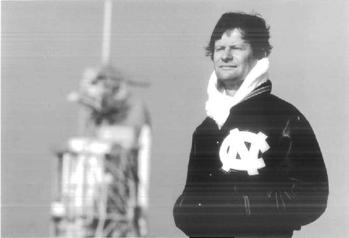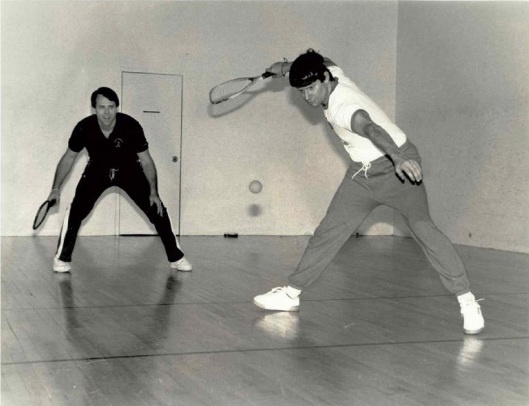Space
"...the space agency announced a second competition to follow the first teacher with the first writer in space...I leapt at the opportunity, knowing full well---to stretch a metaphor---that it was a long shot."

Reston during writer in space competition
In the early 1980s NASA announced a program to put the first teacher in space. A nationwide competition was initiated for the best candidate, and 11,000 teachers applied. Ultimately, the “winner” was a bubbly high school teacher from New Hampshire named Christa McAuliffe. As McAuliffe’s training got under way in Houston, the space agency announced a second competition to follow the first teacher with the first writer in space.
At that point only about 100 people had experienced space travel. After the glory days of Apollo and the first man on the moon, space travel on the space shuttle had, in the minds of many, become routine and boring, (though it was anything but.) The writer-in-space program was meant to reinvigorate interest in the program.
I leapt at the opportunity, knowing full well---to stretch a metaphor---that it was a long shot. Walter Cronkite and Tom Brokaw were among my competitors. But why not? Go for it! To bolster my candidacy, I began to hang out at the Johnson Space center outside of Houston and befriend a number of astronauts, including a school mate of mine, a navy captain named Frederick Hauck. Rick Hauck was slated to command an amazing, upcoming shuttle mission to recapture a broken satellite in space called Palapa. (see picture above). Over time, I wrote articles for Esquire, National Geographic, and the New York Times Magazine, and did a PBS Frontline documentary on space risk. With these credentials I was able to persuade Newsweek, PBS, and the BBC to be their candidate. As a show of my worthiness, I attended a number of shuttle launches, and began high-profile workouts, including racquetball sessions with former UNC basketball star, John Kuester. (now the coach of the Detroit Pistons. (See picture below.)
Of course, this all went up in smoke 73 seconds into Christa McAuliffe’s mission on January 28, 1986. Both teacher and writer programs were scrapped, (although the teacher program was revived many years later.) Capt. Rick Hauck was chosen to command the first shuttle mission after the Challenger disaster. I was to write about the preparations for that mission and do another PBS film about it.
In retrospect, I suppose the most important consequence of my space obsession in the 1980s was to give me a deep interest in astronomy. And that would lead to my National Geographic piece on the Orion constellation and my cover story in Time Magazine, May 23, 1994, on the incredible collision of so called Shoemaker-Levy 9 comets into the planet Jupiter. But most importantly, it would lead to my biography of Galileo, a book that would change the course of my career dramatically.
"Masterful....A brilliant biography."
Washington Post Book World on Galileo: A Life
At that point only about 100 people had experienced space travel. After the glory days of Apollo and the first man on the moon, space travel on the space shuttle had, in the minds of many, become routine and boring, (though it was anything but.) The writer-in-space program was meant to reinvigorate interest in the program.
I leapt at the opportunity, knowing full well---to stretch a metaphor---that it was a long shot. Walter Cronkite and Tom Brokaw were among my competitors. But why not? Go for it! To bolster my candidacy, I began to hang out at the Johnson Space center outside of Houston and befriend a number of astronauts, including a school mate of mine, a navy captain named Frederick Hauck. Rick Hauck was slated to command an amazing, upcoming shuttle mission to recapture a broken satellite in space called Palapa. (see picture above). Over time, I wrote articles for Esquire, National Geographic, and the New York Times Magazine, and did a PBS Frontline documentary on space risk. With these credentials I was able to persuade Newsweek, PBS, and the BBC to be their candidate. As a show of my worthiness, I attended a number of shuttle launches, and began high-profile workouts, including racquetball sessions with former UNC basketball star, John Kuester. (now the coach of the Detroit Pistons. (See picture below.)
Of course, this all went up in smoke 73 seconds into Christa McAuliffe’s mission on January 28, 1986. Both teacher and writer programs were scrapped, (although the teacher program was revived many years later.) Capt. Rick Hauck was chosen to command the first shuttle mission after the Challenger disaster. I was to write about the preparations for that mission and do another PBS film about it.
In retrospect, I suppose the most important consequence of my space obsession in the 1980s was to give me a deep interest in astronomy. And that would lead to my National Geographic piece on the Orion constellation and my cover story in Time Magazine, May 23, 1994, on the incredible collision of so called Shoemaker-Levy 9 comets into the planet Jupiter. But most importantly, it would lead to my biography of Galileo, a book that would change the course of my career dramatically.
"Masterful....A brilliant biography."
Washington Post Book World on Galileo: A Life
Articles: “Lost in Space”
About astronaut Rick Hauck, appeared in The Washingtonian, Feb. 1985 view PDF "THE ASTRONAUTS AFTER CHALLENGER: ASTRONAUTS ASTRONAUTS" Appeared in New York Times Jan. 25, 1987 pg. SM46 (found in ProQuest Historical Newspapers) view PDF “Collision Course” Cover story on Shoemaker-Levy 9 comet crash into Jupiter, appeared in TIME May 23, 1994 view PDF "Hoot Gibson Has the Right Iaisa" Appeared in Esquire, June 1995 view PDF “Orion: Where Stars are Born” Appeared in National Geographic Magazine, Dec. 1995 view PDF |
